Minimalist Interior Design: Complete Style Guide
Minimalist interior design embraces the philosophy of "less is more"—creating serene, uncluttered spaces through clean lines, neutral palettes, and intentional curation. This comprehensive guide teaches you how to achieve authentic minimalist design with practical decluttering strategies, budget-friendly tips, and 50+ real room transformations for inspiration.
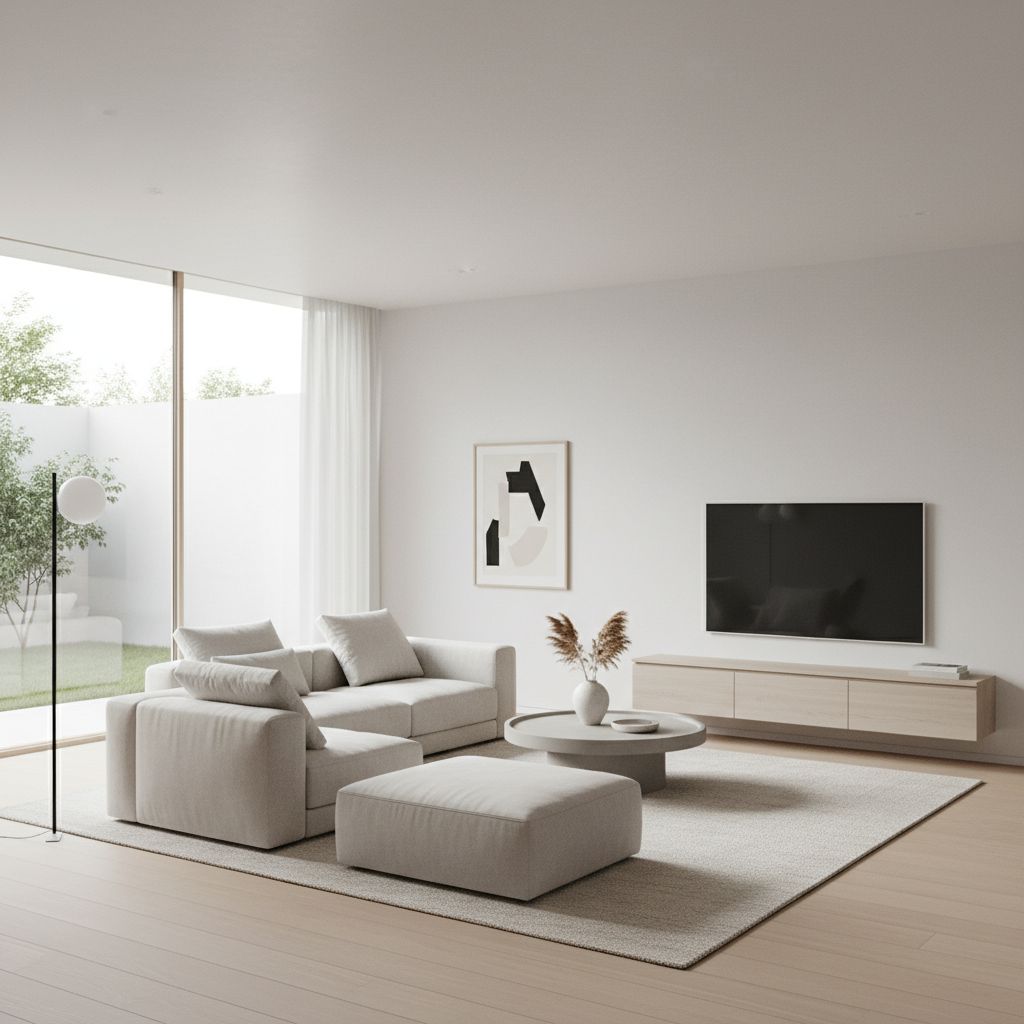
Modern minimalist interior design: serene, functional, and beautifully simple
What is Minimalist Interior Design?
Minimalist interior design is a design philosophy rooted in the principle of "less is more"—creating intentionally simple, uncluttered spaces that focus on what truly matters. Born from the Japanese aesthetic of Zen Buddhism and popularized by the Bauhaus movement in the 1920s, minimalist interior design strips away the unnecessary to reveal the essential beauty of form and function.
Unlike maximalist or eclectic design styles that celebrate abundance and variety, minimalist interior design embraces restraint and intentionality. Every piece in a minimalist space must serve a clear purpose—either functional or bringing genuine joy. There are no "filler" items, no decorative clutter, and no excess. What remains is a calm, serene environment that promotes clarity, focus, and intentional living.
Modern minimalist interior design doesn't mean cold or sterile—that's a common misconception. True minimalist design is warm minimalism, creating cozy, inviting spaces through carefully chosen textures, natural materials, and thoughtful lighting. It's about quality over quantity—choosing fewer but better pieces that you truly love and that will last for decades.
Why Minimalist Interior Design Remains Relevant in 2025
As modern life becomes increasingly cluttered with digital distractions, consumer goods, and constant stimulation, minimalist interior design offers a sanctuary. The style has evolved from stark white boxes to include warmer palettes, natural materials, and personal touches—making it more accessible and livable than ever.
- Mental clarity: Clutter-free spaces reduce stress and improve focus
- Time freedom: Less stuff means less cleaning and organizing
- Financial benefits: Buying fewer, better items saves money long-term
- Environmental impact: Reduced consumption means less waste
- Versatility: Works in any space size, especially small apartments
Perfect for: People overwhelmed by clutter, those valuing quality over quantity, urban dwellers in small spaces, anyone seeking calm and clarity, professionals wanting distraction-free homes, individuals transitioning to intentional living, people with allergies (fewer dust collectors!), and busy individuals wanting easy-to-maintain homes.
9 Key Elements of Minimalist Interior Design
Understanding these core characteristics will help you create authentic minimalist interior design that feels cohesive, calm, and purposeful:
1. Clean, Simple Lines
Minimalist interior design features furniture and architecture with straight, unadorned lines and geometric forms. Sofas have sleek profiles without ornate details, tables are simple rectangles or circles, and decorative molding is minimal or absent. The beauty in minimalist design comes from the purity of form rather than decorative embellishment.
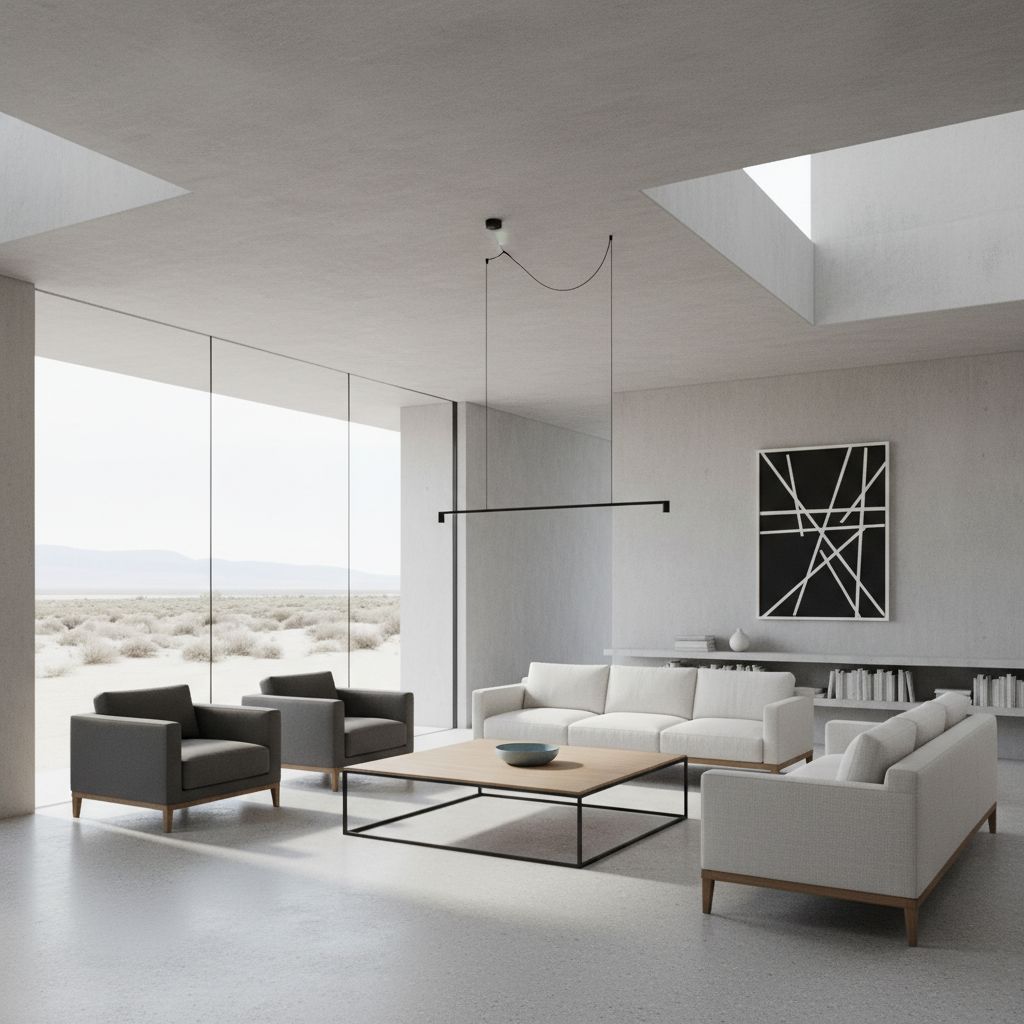
2. Neutral Color Palette
The foundation of minimalist interior design is a monochromatic or neutral color scheme. Whites, off-whites, beiges, grays, and blacks create a calm, cohesive look. This doesn't mean sterile—warm whites, soft beiges, and greiges (gray-beige) add warmth to minimalist interiors. Pops of color come sparingly through one or two accent pieces, creating visual peace and making spaces feel larger.
3. Intentional Negative Space
Also called "white space," negative space is the empty area around and between objects in minimalist interior design. This spaciousness is intentional and valuable—not "wasted." Empty walls, clear countertops, and uncluttered floors give the eye places to rest. Every item needs breathing room in minimalist design. If a room feels crowded, remove items until it feels balanced.
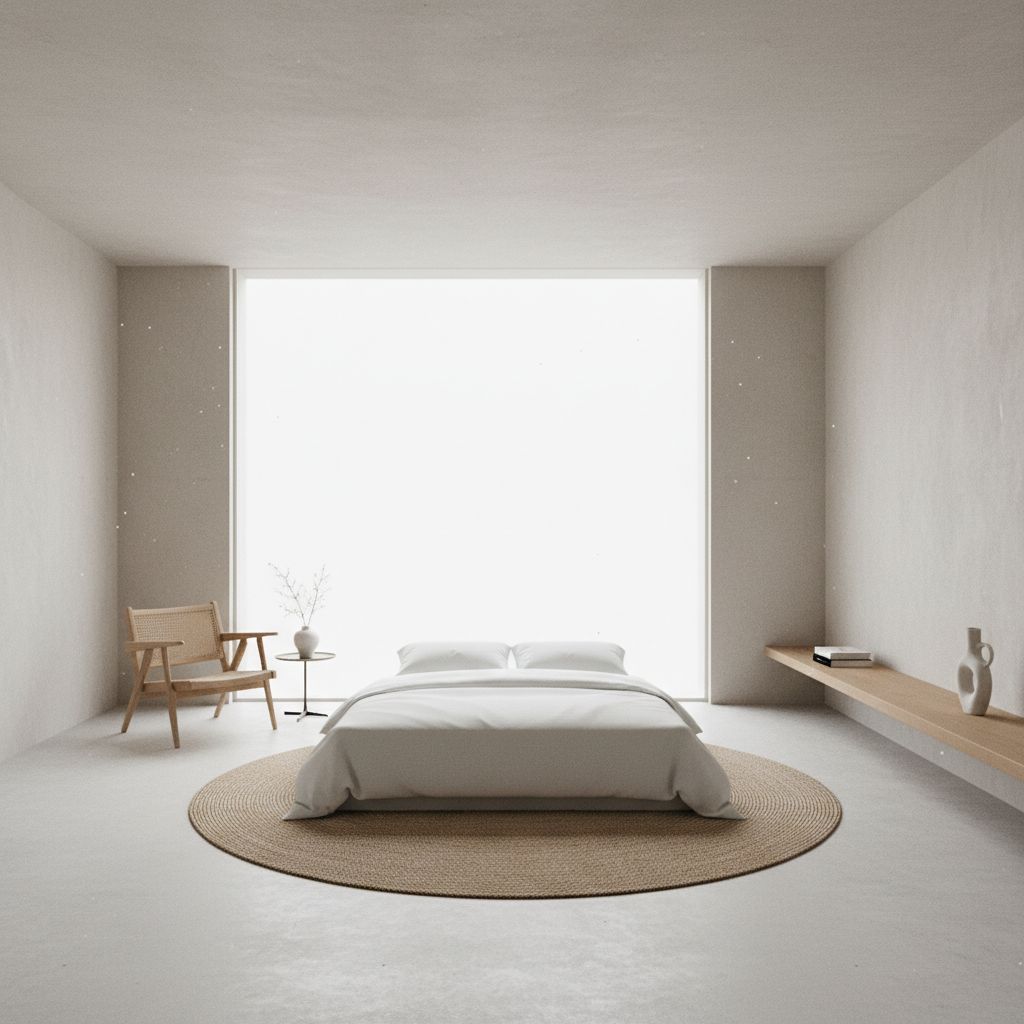
4. Function Over Form (But Beautiful Function)
Every item in minimalist interior design must earn its place by being useful. Furniture should be functional first—but that doesn't mean ugly! The best minimalist pieces are both highly functional AND beautiful in their simplicity. A sleek sofa comfortable for daily use, a dining table serving as both workspace and gathering place, storage that conceals clutter while looking elegant.
5. Quality Over Quantity
Minimalist interior design prioritizes quality investment over cheap abundance. Instead of ten mediocre pillows, have two exceptional ones in natural linen. Instead of fast furniture that falls apart, invest in one well-made piece lasting decades. Choose solid wood over particle board, natural fibers over synthetics, craftsmanship over mass production. Fewer items means you can afford better quality.
6. Natural Materials & Textures
To prevent minimalist interior design from feeling cold, incorporate natural materials: wood (especially light woods like oak, ash, or maple), stone, concrete, linen, cotton, wool, leather, and ceramic. These materials add warmth and tactile interest without visual clutter. A wooden coffee table, linen curtains, wool rug, and ceramic vases bring life to neutral minimalist spaces through texture.
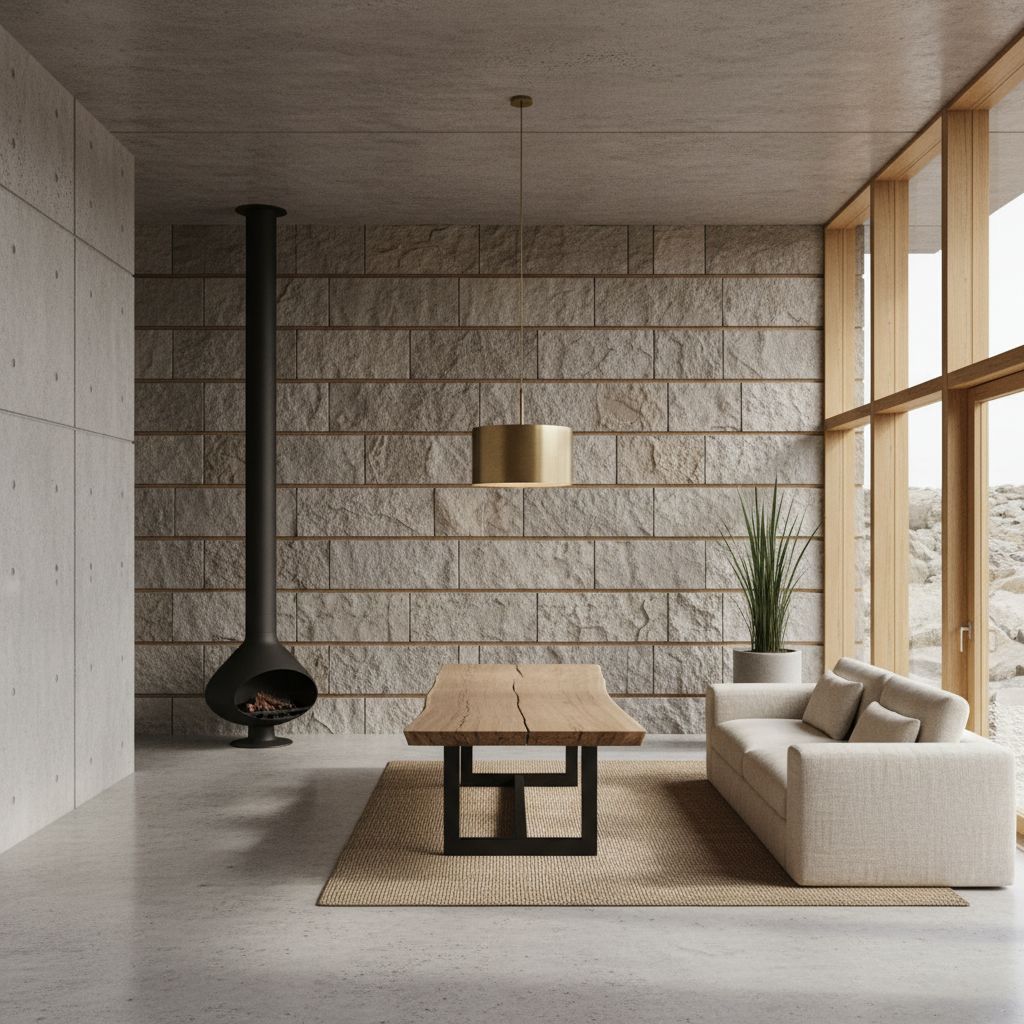
7. Concealed Storage & Clutter-Free Surfaces
The "magic" of minimalist interior design? Everything has a home, and most things are hidden. Built-in cabinets, closed storage, under-bed storage, and furniture with hidden compartments keep daily clutter out of sight. Countertops are clear except for essential items. Coffee tables have one or two objects maximum. The goal: when you look around, you see calm, not chaos.
8. Intentional, Layered Lighting
Lighting is crucial in minimalist interior design. Maximize natural light—keep windows unobstructed, use sheer curtains. Layer artificial lighting: recessed ceiling lights for ambient glow, sculptural floor or table lamps as statement pieces, task lighting where needed. Fixtures should be simple and beautiful—Scandinavian pendant lights or Japanese paper lanterns rather than ornate chandeliers.
9. Thoughtful, Limited Decor
Minimalist interior design doesn't mean no personality—it means intentional personality. Choose a few meaningful pieces rather than covering every wall. One large piece of art makes more impact than ten small ones. A single sculptural vase, not a collection. Three well-chosen books on a shelf, not thirty spine-out. Each decorative item should be something you genuinely love.
Minimalist Interior Design Color Palette
The minimalist interior design color palette creates serenity through restraint. Here's how to build your minimalist color scheme:
Base Colors
Foundation of minimalist interiors:
- • Pure white & off-white
- • Warm beige & greige
- • Soft gray (warm-toned)
- • Cream & ivory
Accent Neutrals
Add depth to minimalist design:
- • Natural wood tones
- • Warm taupe
- • Soft black (charcoal)
- • Warm brown
Optional Accents
Sparingly used pops:
- • Muted sage green
- • Soft dusty blue
- • Warm terracotta
- • Deep charcoal blue
The 90-8-2 Rule for Minimalist Interior Design:
- 90% Neutrals: Walls, floors, large furniture in whites, beiges, grays
- 8% Natural Tones: Wood, stone, warm neutrals through materials and textures
- 2% Accent (Optional): One or two items in muted accent color
Warm vs. Cool Minimalist Interior Design:
🔥 Warm Minimalism (Recommended)
- • Warm whites (cream, ivory)
- • Beiges and greiges
- • Natural wood (oak, walnut)
- • Feels cozy and inviting
❄️ Cool Minimalism
- • Pure white, stark white
- • Cool grays
- • Metal and glass
- • Feels modern and crisp
2025 trend: Warm minimalist interior design has become dominant, creating livable spaces rather than showrooms.
How to Create Minimalist Interior Design: 8-Step Guide
Achieving authentic minimalist interior design isn't about throwing everything away—it's about intentional curation. Follow this step-by-step process:
Step 1: Declutter First (Essential for Minimalist Interior Design)
You cannot create minimalist interior design without decluttering first. Go room by room and honestly assess every item:
- The Minimalist Test: Ask "Does this serve a clear purpose OR bring genuine joy?" If no to both, it goes.
- Remove duplicates: Keep the best one or two of everything
- Clear surfaces completely: Start empty, add back only essentials
- The 90/90 Rule: Haven't used it in 90 days and won't in next 90? Donate it.
Step 2: Choose Your Minimalist Color Palette
Select 2-3 neutral colors forming your minimalist interior design foundation:
- Walls: Warm white, soft beige, or light greige
- Large furniture: Neutral upholstery or natural materials
- Accent neutral: One darker tone for depth and grounding
Warm minimalist interior design (creams, beiges, warm grays) is more livable than stark white minimalism.
Step 3: Invest in Quality, Multi-Functional Furniture
Minimalist interior design is about fewer pieces of higher quality. Each piece should be:
- Simple in design: Clean lines, no ornate details
- Multi-functional: Coffee tables with storage, beds with drawers
- Well-made: Solid wood, quality upholstery, lasting decades
- Appropriately sized: Right scale for your room
Step 4: Maximize Storage in Minimalist Interior Design
The secret to minimalist spaces: everything has a home, most things hidden:
- Built-in storage: Floor-to-ceiling cabinets, wall-mounted shelving
- Furniture with concealed storage: Beds with drawers, storage ottomans
- Under-utilized spaces: Under beds, inside ottomans, vertical walls
- "One in, one out" rule: Maintain equilibrium
Step 5: Add Warmth Through Natural Materials
This separates warm, livable minimalist interior design from cold, sterile spaces:
- Wood: Light woods (oak, ash, maple) or richer walnut/teak
- Natural textiles: Linen curtains, wool rugs, cotton bedding
- Stone & ceramic: Marble surfaces, ceramic dishware
- Leather: Cognac or black leather aging beautifully
Step 6: Curate Decor Intentionally
Every decorative item must earn its place in minimalist interior design:
- Art: One large piece over many small ones
- Plants: 2-4 plants max per room, larger statement plants
- Books: Display only current reads or favorites
- Objects: Rule of three or one standout piece alone
Step 7: Perfect Your Lighting
Lighting can make or break minimalist interior design:
- Natural light: Maximize it, keep windows unobstructed
- Ambient lighting: Recessed ceiling or track lighting
- Task lighting: Reading lamps, under-cabinet lights
- Statement lighting: One sculptural pendant or floor lamp
- Warm bulbs only: 2700K-3000K creates cozy ambiance
Step 8: Maintain Your Minimalist Interior Design
Creating minimalist spaces is easier than maintaining them:
- Daily reset: 10 minutes before bed returning everything to place
- Weekly edit: Scan rooms for accumulated items
- Seasonal purge: Four times yearly, deeper declutter
- Mindful consumption: Before buying, ask "Do I need this?"
50+ Minimalist Interior Design Transformations
See how cluttered, busy rooms transform into serene minimalist interior design. These examples show the power of "less is more":
Minimalist Living Room Interior Design
Cluttered living room transformed to calm minimalist interior design
Small living room maximized with minimalist design principles
Modern minimalist living room with warm wood accents
Bright minimalist interior design with intentional negative space
Minimalist Bedroom Interior Design
Busy bedroom transformed to serene minimalist retreat
Small minimalist bedroom with smart storage solutions
Warm minimalist interior design with natural wood and linen
Japanese-inspired minimalist bedroom design
Minimalist Kitchen & Bathroom Interior Design
Minimalist kitchen interior design with clear counters
Spa-like minimalist bathroom design
Want to visualize minimalist interior design in your space? Upload a photo to see different minimalist variations before making changes.
Budget-Friendly Minimalist Interior Design
Minimalist interior design is actually budget-friendly—fewer items means less spending! Here's how to create minimalist spaces affordably:
The Minimalist Advantage
Unlike other styles, minimalist interior design saves money by design:
- Fewer items to buy overall
- No decorative "filler" needed
- Neutral base = less redecorating
- Quality over quantity = buy once
- What you own, you truly use
Start with What You Have
Minimalist interior design often starts free—just remove items:
- Declutter ruthlessly (costs $0)
- Remove excess furniture and decor
- Clear surfaces completely
- Rearrange remaining pieces
- Live with less before buying more
Budget Minimalist Interior Design Breakdown:
Transform a room for $800-1,200:
Common Minimalist Interior Design Mistakes
Even simple design can go wrong. Avoid these minimalist interior design pitfalls:
Mistake #1: Too Cold and Sterile
The Problem: All-white everything makes minimalist interior design feel like a hospital, not a home.
The Fix: Add warmth through natural materials (wood, linen, wool), warm-toned whites instead of stark white, soft lighting, and plants. The space should feel calm, not clinical.
Mistake #2: Confusing Minimalism with Being Cheap
The Problem: Buying cheapest furniture because you only need "a few pieces." Result: low-quality items that fall apart.
The Fix: Minimalist interior design is about quality over quantity. Save up for one excellent sofa rather than buying cheap. Quality pieces last decades.
Mistake #3: No Storage Solutions
The Problem: Decluttering surfaces but having no organized storage means chaos behind closed doors.
The Fix: Invest in proper storage systems for minimalist interior design—built-in cabinets, drawer organizers, closet systems. Everything needs a designated home.
Mistake #4: No Personality
The Problem: Minimalist interior design looks like a catalog or hotel room with zero personality.
The Fix: Display a few cherished photos, show one meaningful art piece, keep favorite books visible. The space should feel like yours, just curated.
Minimalist Interior Design by Room Type
Adapt minimalist interior design principles to every room:
Minimalist Living Room Design
One quality sofa, one coffee table, minimal media storage. Keep surfaces clear. Hide cords and tech. Use closed storage for miscellaneous items. Large windows, sheer curtains, thoughtful lighting create ambiance in minimalist living rooms.
Key minimalist elements: Comfortable neutral sofa, simple coffee table, concealed storage, one art piece, 2-3 plants max.
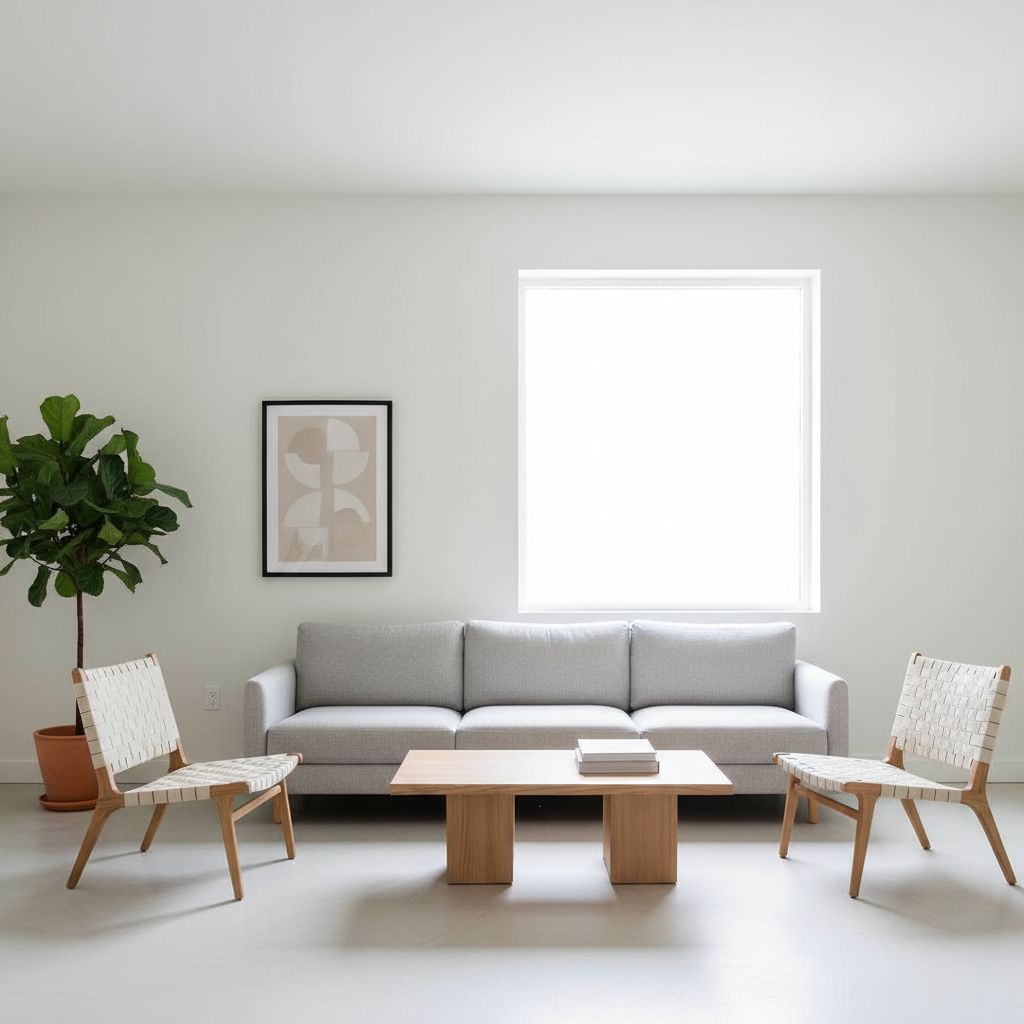
Minimalist Bedroom Design
Your sleep sanctuary should be the most minimal room. Simple bed frame, quality bedding in neutrals, minimal nightstands. Clear all surfaces before bed. Blackout curtains, closed closets, one piece of art max in minimalist bedrooms.
Key minimalist elements: Simple bed, quality neutral bedding, minimal nightstands, concealed clothing storage.
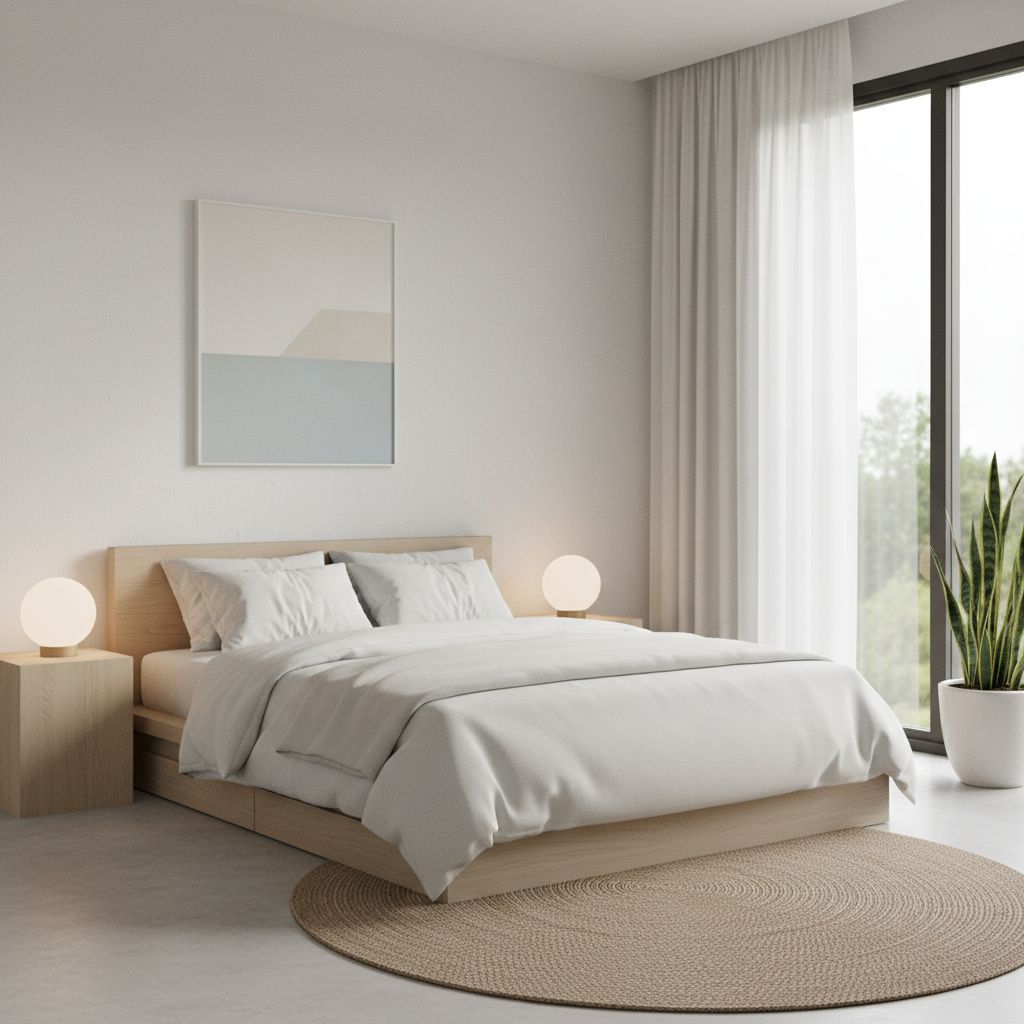
Minimalist Kitchen Design
Functionality paramount in minimalist kitchen design. Clear countertops (only daily-use items visible), closed cabinets, simple hardware, quality over quantity in cookware. Keep only what you actually use in minimalist kitchens.
Key minimalist elements: Clear counters, closed storage, quality essentials, neutral palette.
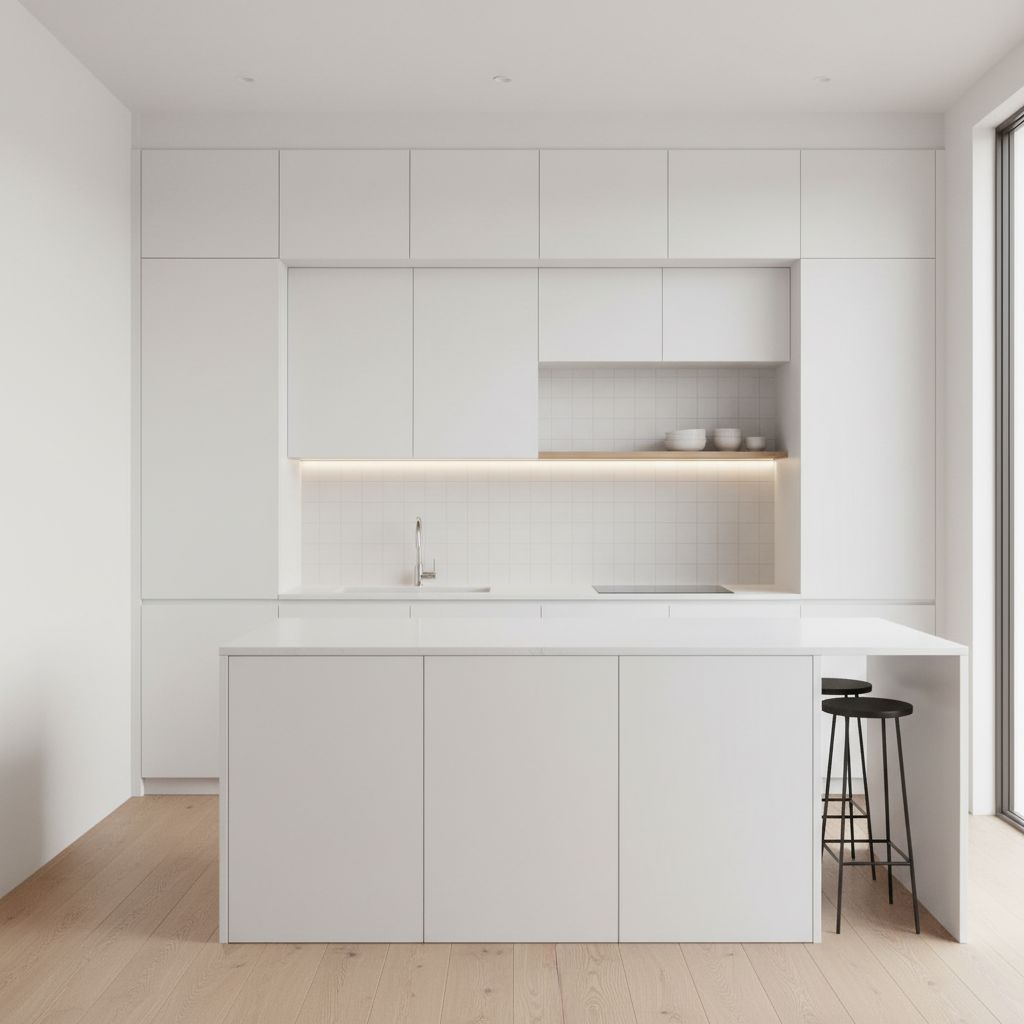
Minimalist Bathroom Design
Spa-like and serene minimalist bathrooms. Wall-mounted vanity, concealed storage for toiletries, simple mirror, minimal decor (one plant). Use natural materials—wood, stone, ceramic in minimalist bathroom design.
Key minimalist elements: Wall-mounted vanity, concealed storage, simple mirror, natural materials.
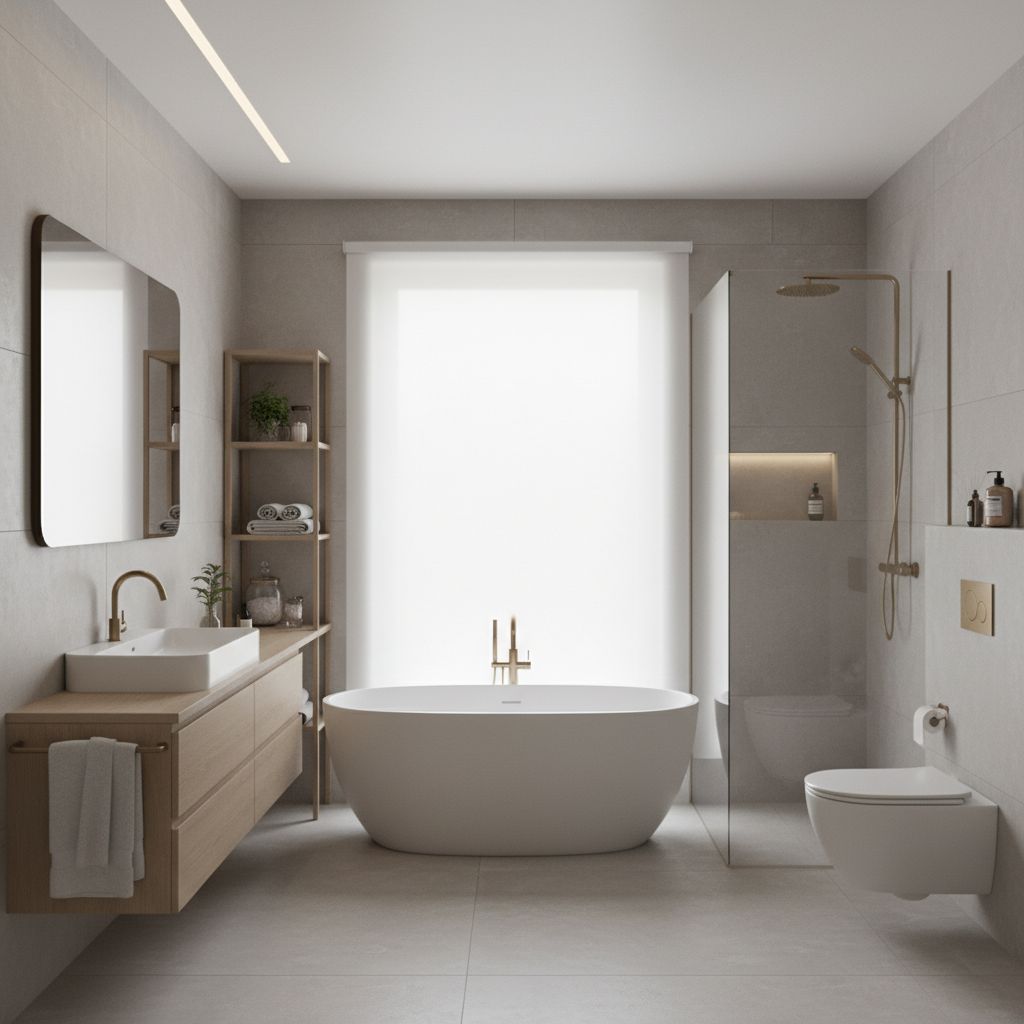
Minimalist Home Office Design
Distraction-free workspace for productivity. Simple desk, ergonomic chair, minimal desk accessories, closed storage, cable management. Keep desk clear except when working in minimalist offices.
Key minimalist elements: Clean-lined desk, comfortable chair, concealed storage, managed cables.
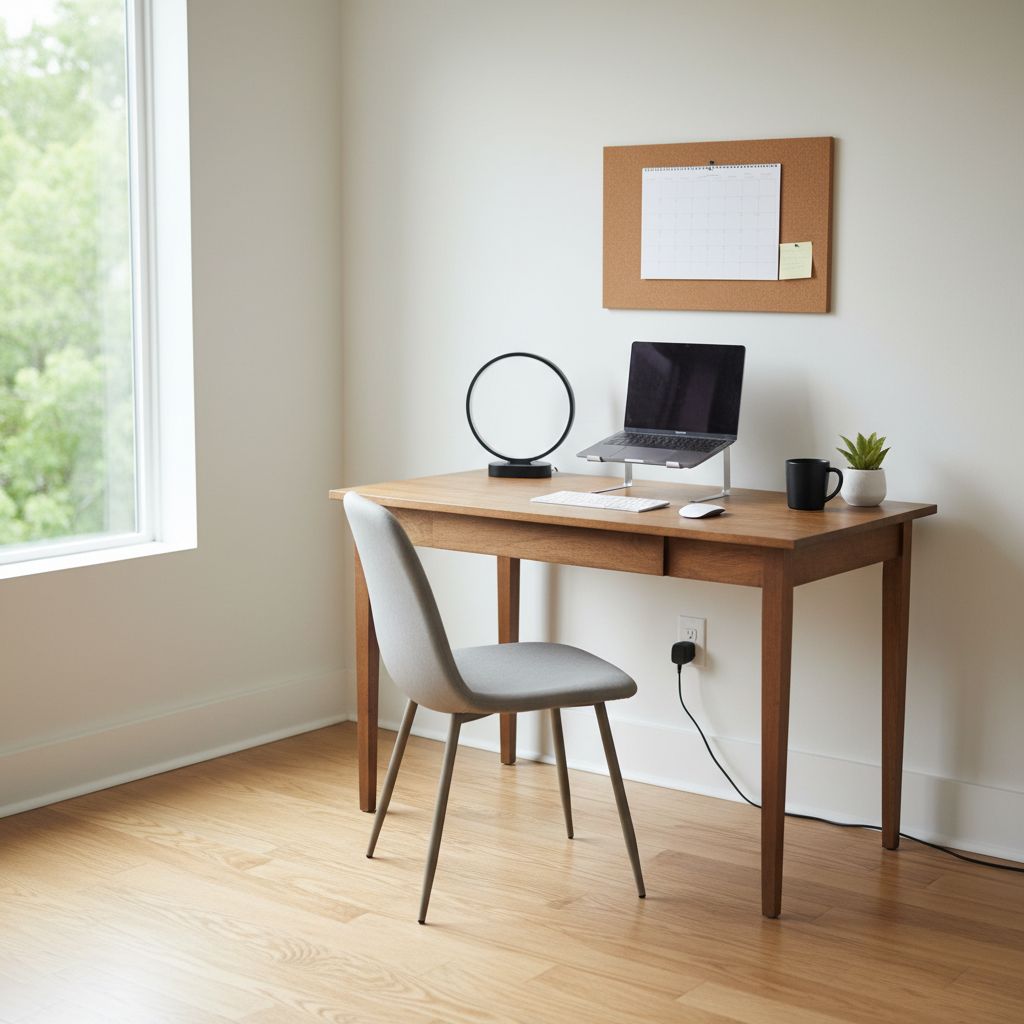
Minimalist Dining Room Design
Focused on gathering and meals. Simple dining table, clean-lined chairs, one statement pendant light. No extra furniture needed. Keep table clear except during meals in minimalist dining rooms.
Key minimalist elements: Simple table, streamlined chairs, statement lighting.
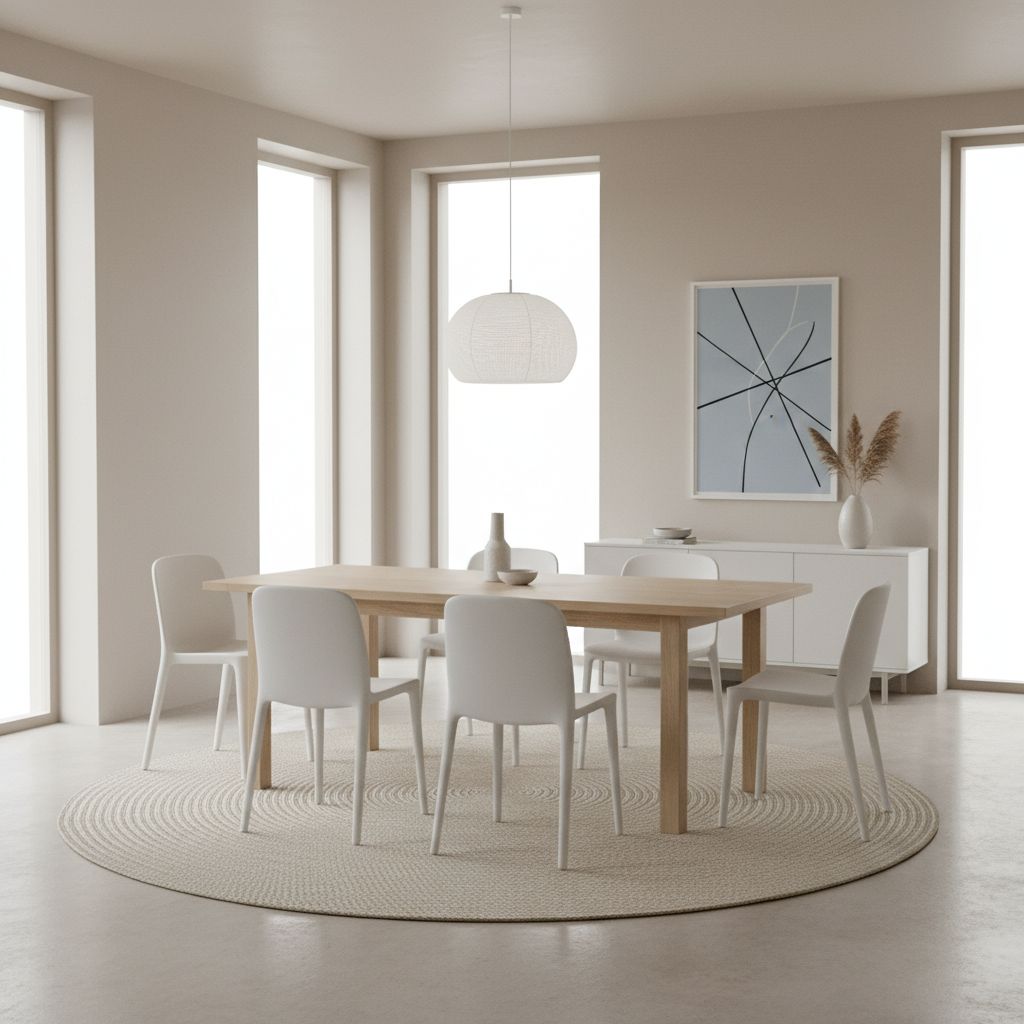
Interior Design Styles Similar to Minimalism
If minimalist interior design resonates with you, explore these complementary styles:
Scandinavian Interior Design
Shares minimalist interior design's clean lines and neutral palettes but adds more warmth, coziness (hygge!), and natural materials. Scandinavian design is minimalism's friendlier cousin—still simple but with more texture and inviting comfort.
→ Explore Scandinavian StyleModern Interior Design
Modern and minimalist interior design overlap significantly—both favor clean lines, neutral colors, uncluttered spaces. Modern design can be more dramatic with bold materials (glass, steel) and stronger contrasts.
→ Explore Modern StyleJapanese Interior Design
Minimalist interior design has deep roots in Japanese aesthetics—Zen Buddhism, wabi-sabi, and ma (negative space). Japanese design takes minimalism further with low furniture, natural materials, and profound simplicity.
→ Explore Japanese StyleContemporary Interior Design
Contemporary is minimalist interior design's more flexible sibling. Shares clean lines and uncluttered spaces but adapts to current trends—sometimes adding more color or mixing styles more freely.
→ Explore Contemporary StyleMinimalist Interior Design: Frequently Asked Questions
What is minimalist interior design?
Minimalist interior design is a philosophy of "less is more"—creating intentionally simple, uncluttered spaces focused on essentials. It features clean lines, neutral color palettes, quality over quantity, functional furniture, concealed storage, and abundant negative space. Every item in minimalist design serves a purpose (functional or bringing joy) with no excess or filler.
Is minimalist interior design expensive?
No! Minimalist interior design is budget-friendly because you buy fewer items overall. The style prioritizes quality over quantity—one excellent sofa costs less than furnishing an entire room with mediocre pieces. Start minimalism for free by decluttering. When you do buy, invest in quality pieces lasting decades. Most people find minimalist design saves money through reduced consumption.
How do I start creating minimalist interior design?
Start minimalist interior design by decluttering one small area. Remove everything that doesn't serve a clear purpose or bring genuine joy. Choose 2-3 neutral colors for your palette. Invest in quality, multi-functional furniture with clean lines. Create proper storage systems. Add warmth through natural materials (wood, linen, wool) and thoughtful lighting. Live with less for a few weeks before adding anything new.
Does minimalist interior design mean no personality or color?
Absolutely not! Minimalist interior design can have personality—just expressed intentionally. Display a few meaningful items you truly love. Include color purposefully—one accent wall, art with color, or plants. The key is curation in minimalism: fewer items mean what you do display gets more attention and impact.
How do I keep minimalist interior design from feeling cold?
The secret to warm minimalist interior design: use warm-toned whites and beiges instead of stark white; incorporate natural materials like wood, linen, wool for texture; layer lighting with warm bulbs (2700-3000K); add 2-4 plants for life; include soft textiles like throws and rugs; choose comfortable, inviting furniture. The goal is serene and calm, not cold.
Can minimalist interior design work in small spaces?
Minimalist interior design is perfect for small spaces! Removing clutter and excess makes small rooms feel larger and more breathable. Use multi-functional furniture (storage beds, folding tables), keep color palettes light and neutral, maximize vertical storage, choose appropriately-scaled furniture, maintain clear surfaces and floors. Small minimalist spaces feel airy and calm.
What colors work best for minimalist interior design?
Minimalist interior design uses neutral palettes: whites (warm white, off-white, cream), beiges and greiges (gray-beige), soft grays (warm-toned), natural wood tones, and black or charcoal for contrast. Optional accent colors used sparingly: muted sage green, soft dusty blue, warm terracotta. The key is cohesion—stick to 2-3 main neutrals throughout your minimalist space.
Is minimalist interior design the same as Scandinavian design?
They're related but not identical. Scandinavian design embraces minimalist interior design principles (clean lines, neutral palette, functionality) but adds more warmth, coziness (hygge), natural materials, and sometimes pattern and color. Scandinavian is like warm minimalism with more personality. Both share Nordic influences and functionality-first philosophy.
What's the difference between minimalist and modern interior design?
Minimalist and modern interior design overlap but aren't identical. Minimalism is a philosophy about simplicity and removing excess. Modern design refers to a specific mid-20th century style (1920s-1950s) with clean lines, new materials (glass, steel), and breaking from tradition. Modern design tends to be more dramatic with stronger contrasts, while minimalist interior design prioritizes calm neutrality.
How many items should a minimalist have?
There's no magic number in minimalist interior design! Minimalism isn't about counting possessions—it's about intentionality. The question isn't "how many items" but "does each item serve a purpose or bring genuine joy?" Focus on removing what doesn't add value rather than hitting an arbitrary number. What matters is that everything in your minimalist space is intentional and used.
Your Minimalist Interior Design Journey
Minimalist interior design is about creating a space that enhances your life through simplicity—fewer possessions, more freedom; less clutter, more clarity; quality over quantity, calm over chaos. Whether you're drawn to warm minimalism's cozy textures or cool minimalism's crisp lines, the beauty lies in intentional curation.
Start small: declutter one drawer, clear one surface, remove one unnecessary item. Each step compounds into significant change. The goal isn't deprivation—it's freedom.
Want to visualize different minimalist interior design styles in your space before making changes?
Upload a photo • Choose minimalist style • See instant results
